Poster - Hipparcos
Hipparcos Pinpoints the Stars |
|
|
A new revolution in astrometry |
|
|
In 129 BC the Greek astronomer Hipparchus completed a catalogue of a thousand stars. By noting their directions in the sky and their relative brightnesses, he founded the science of astrometry, or star measurement. Hipparchus specified the directions of stars to about one degree -- the angle made by a man's height at a distance of 100 metres. |
|
 |
|
|
A French proposal, in 1966, called for a satellite to map the whole sky. The European Space Agency developed the concept in a multinational project. Three decades after the idea was mooted the results are in, thanks to the satellite called Hipparcos. It delivers a hundredfold improvement. At a thousandth of a second of arc, or less than a millionth of a degree, Hipparcos has fixed directions, distances and motions of stars with an accuracy equivalent to observing an astronaut's height at the distance of the Moon. Astronomers will now re-assess all that they believed they knew about stars and their evolution. Tycho Brahe's revolution in astrometry let Kepler and Newton settle the argument about the nature of the Solar System. After Hipparcos, who knows how opinions about the Universe will change, when astronomers digest the results of this new tour de force of Europe's space science? |
|
The 3-dimensional Galaxy around us |
|
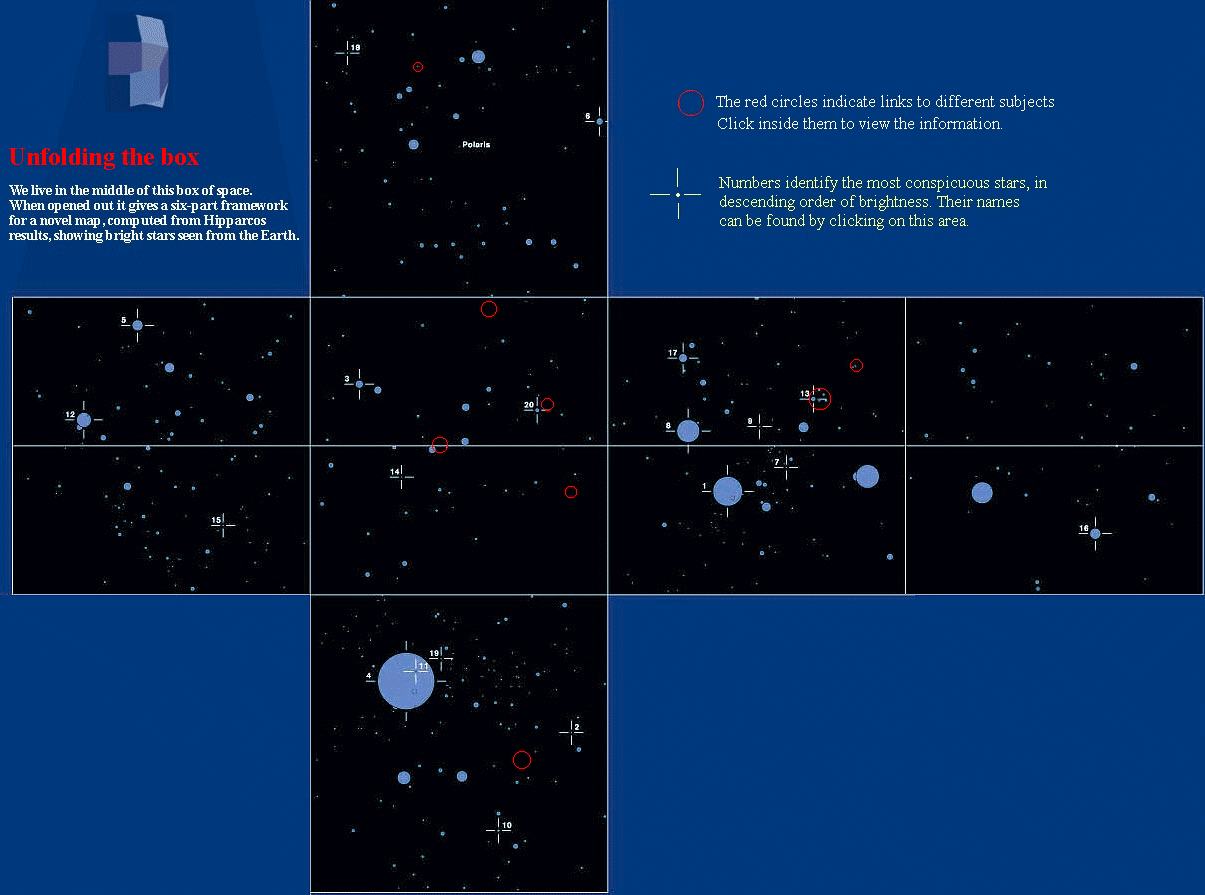 |
|
The brightest stars |
|
| The map above shows the stars seen most easily with the naked eye (magnitude 4 or brighter). All are treated as if they were the same size, so that a star's width on the map gives an impression of its relative distance as measured by Hipparcos. Numbers identify the most conspicuous stars, in descending order of brightness. | |
|
|
The Warp in the Milky Way |
|
|
The Sun and many other stars orbit around the centre of the Milky Way Galaxy in a flattened disk. By looking away from the centre, and choosing distant stars from Hipparcos data, astronomers at the Turin Observatory and Oxford University confirm that the disk is not really flat. Outside the Sun's orbit, stars follow tilted orbits. |
|
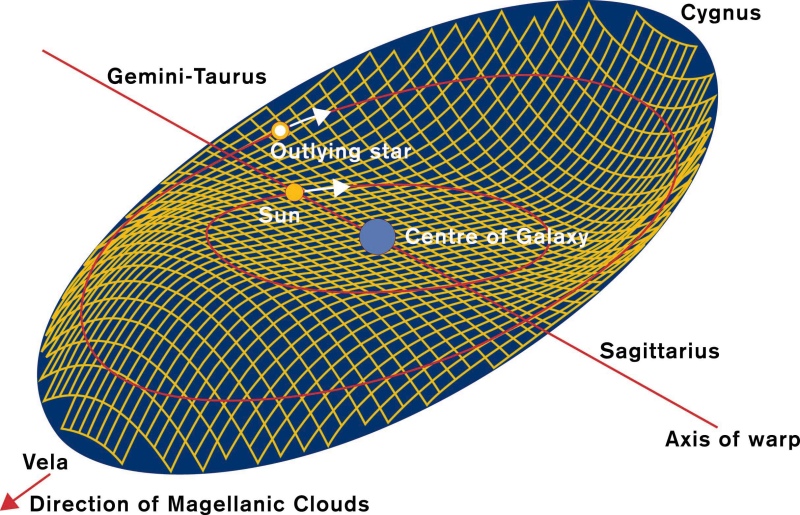 |
|
Distance to the Pleiades |
|
|
Hipparcos has discovered that one of the best-known star clusters, the Pleiades (or the Seven Sisters as they are also called), is closer than expected. The new distance determined by the Hipparcos mission is 375 light-years putting the cluster about 10 per cent closer than previously thought. The Pleiades have fascinated stargazers since ancient times. Nowadays they are important because the stars in an open cluster were born in the same gas cloud. They all have the same age and chemical make-up. So they helped astronomers to develop the theory which predicts how hot and luminous a star should be, for a given mass, composition and age. The experts have to re-examine some assumptions, now that Hipparcos finds that the Pleiades are less luminous than supposed. |
|
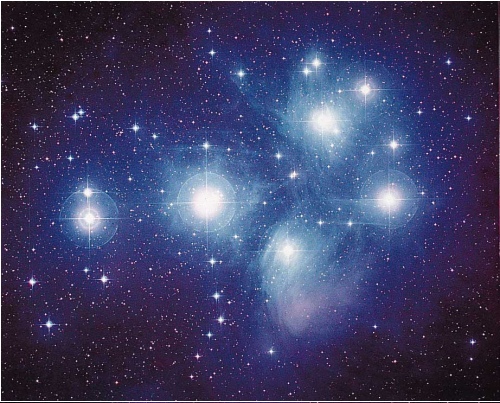 |
|
| (Photo copyright: Royal Observatory, Edinburgh, and Anglo-Australian Telescope Board) | |
Motions of the Hyades |
|
|
Hipparcos data gives new insights into the distance, structure, dynamics and age of the Hyades cluster. An mpeg movie illustrating the 3-dimensional nature of the cluster can be found here. |
|
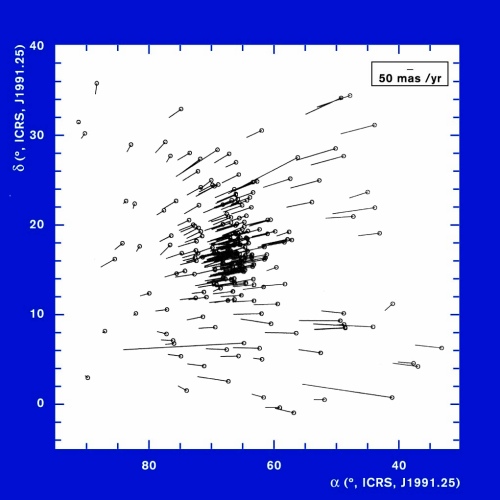 |
|
A brilliant old star |
|
| At 260 light-years the star HIP 48152 is more than twice as far as astronomers believed before Hipparcos, and it is therefore six times more radiant. As an ancient star formed long before the Sun, it helps in estimating distances and ages of many farther stars. The large correction shows why Hipparcos results have jolted star theories. Checking distances to 900 ancient stars, astronomers at the Geneva Observatory find that many have been understated. As a result the stars' ages are doubtful until theories of their evolution have taken in the new, precise information from Hipparcos. | |
Measuring the Universe |
|
|
At 980 light-years, as newly judged by Hipparcos, a winking star called Delta Cephei waxes and wanes every five days. The graph shows its variations as monitored by the satellite. Delta Cephei (which appears in the Hipparcos catalogue as HIP 110991) is the prototype of the Cepheids, the stars that provide the yardstick for the Universe. The more luminous a Cepheid is, the more slowly it winks. |
|
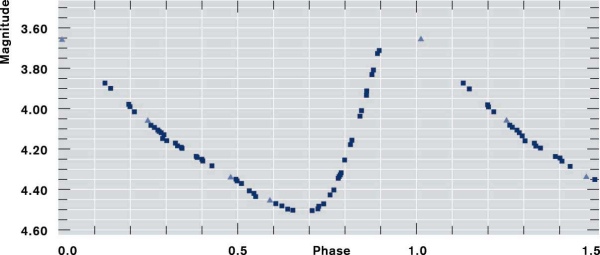 |
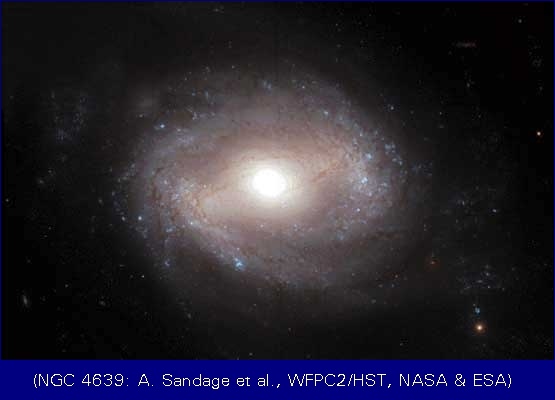 |
|
Direct measurements by Hipparcos, analysed by astronomers in Cape Town and Cambridge, reveal that the nearest Cepheids are more distant and more luminous than astronomers thought. If other Hipparcos data confirm this result, all distances in the Universe at large may increase by ten per cent. |
|
Alien planet |
|
| The star 47 Ursae Majoris (HIP 53721) has an unseen companion, revealed by a wobble that American astronomers detected in 1995. Is it a planet, or a small star? Accurate rangefinding by Hipparcos puts the visible star at 46 light-years, allowing ESA's project scientist to set an upper limit on the companion at 7 to 22 times the mass of Jupiter, the Suns largest planet. The smallest true star would have a mass of 80 Jupiters, so the companion of 47 Ursae Majoris is probably a true planet. | |
Quasar 3C273 |
|
| Hipparcos pinpoints the position of a very distant flaring galaxy. It links, to its scheme of nearer stars, the accurate maps of the radio astronomers and the photographic sky surveys, of which a small extract is shown here. (Copyright of Digitized Sky Survey: STScI, AAO, UK-PPARC and ROE). | |
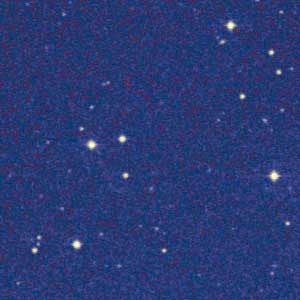 |
|
Seeing double! |
|
| Motions of a double star imaged from Hipparcos data | |
| Double star HIP 46706 | |
 |
|
| credit: C.F. Quist, L. Lindegren & S. Söderhjelm, Lund Observatory, using data from Hipparcos (ESA) | |
|
A succession of three images shows two stars shifting their positions as they orbit around each other in a double-star system and travel together across the sky, as indicated in the diagram below. The images are generated at Lund Observatory, Sweden, from multiple observations by ESA's Hipparcos satellite. |
|
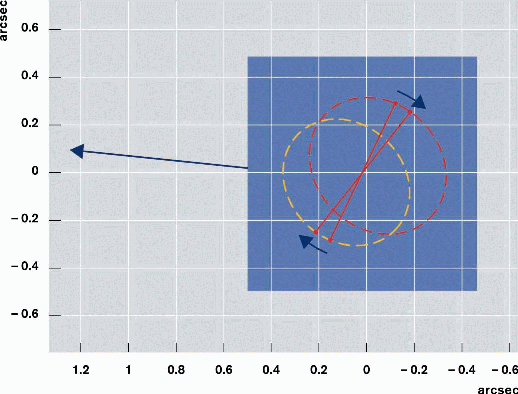 |
|
|
The precision is astonishing. These stars are 34 light-years away and they lie closer together than do the Sun and the planet Saturn. Their separation in the sky is about 1/5000 degree. The Hipparcos mission and subsequent computations have pinpointed the positions of stars with unprecedented accuracy. Hipparcos was not conceived as an imaging instrument, but the Lund team processes its data by the technique of aperture synthesis, originally developed for radio astronomy. The background ripple is a by-product of the method. The double star is in the Hydra constellation. From the very precise measurements, the astronomers compute the masses of the two stars at 0.41 and 0.42 times the mass of the Sun. They orbit around each other every 18.3 years. |
|
Coming our way! |
|
| At 136 light-years and far too faint for the unaided eye to see, the star HIP 23641 is travelling towards us at 54 kilometres per second, according to measurements by telescopes on the ground. Sailors know that an approaching ship whose bearing does not change is on a collision course. By taking the bearings of stars with exceptional precision, Hipparcos can pick out those that will visit the Sun's vicinity. One such, noted at the Royal Greenwich Observatory, is HIP 23641. It shifts its direction by only a few millionths of a degree each year. In 750,000 years' time it will pass at 4 or 5 light-years, which is similar to the distance of the present nearest star system, Alpha Centauri. Without being quite as bright as Alpha Centauri is today, HIP 23641 will then rank among the 40 brightest stars. | |
 |
|
- Removed a total of (35) style text-align:center;
- Removed a total of (2) style text-align:left;
- Removed a total of (1) border attribute.
- Removed a total of (1) cellpadding attribute.
- Removed a total of (1) cellspacing attribute.








































 Sign in
Sign in
 Science & Technology
Science & Technology